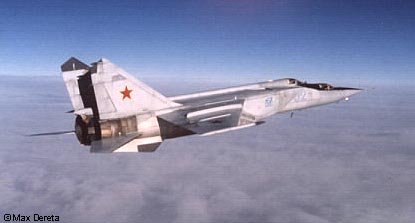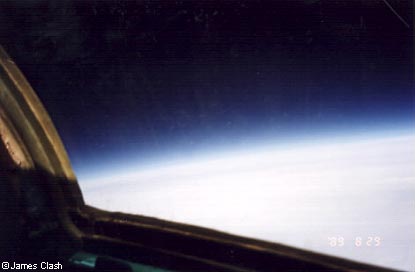
"If I say: 'Jim, eject, eject, eject'--this is not command for discussing, only for fulfilling."
In broken English, Russian pilot Alexander Garnaev is prepping me on emergency evacuation procedures for the MiG-25 fighter jet while his ground crew straps me into the cramped cockpit. I am listening carefully. Garnaev is about to take me to the edge of space at upwards of two-and-a-half times the speed of sound--a mile every two seconds. "But don't pull this handle," he adds, gesturing at the ejection mechanism near my seat. "You could eject me."
When I signed up for this adventure, I knew it wasn't going to be a first-class excursion in a Learjet, but accidental ejection of the pilot--well, that was something I hadn't really considered. No matter, here I am in Russia, donning a pressurized flight suit, helmet and oxygen mask. My heart is racing. Is this how Alan Shepard, the first American into space, felt before his historic flight in 1961?
Shepard's Mercury Redstone topped out at just over 100 miles above the Earth's surface. My ride is only supposed to go to 16 miles. But since that's above 99% of the Earth's atmosphere, much of what one sees--the blackness of space, the curvature of the Earth--is similar to a space flight.
We've gathered at the Gromov Flight Research Institute, Zhukovsky Air Base, about 20 miles southeast of Moscow. During the Cold War the place was so secret it didn't appear on maps. Now tourists--many of them Americans--test their intestinal fortitude from here. A few hundred souls have braved the MiG-25 before me.
Since the 1986 Shuttle Challenger disaster in which a schoolteacher passenger died, NASA refuses to take civilians into space, considered to be 50 miles up. So the MiG ride is as high as most folks can go, except for the occasional Dennis Tito flying to the International Space Station. (With the recent Columbia shuttle disaster, that program is on hold, too.)
On the supply side, times are tough for the Russian military. Soldiers are receiving reduced pay, if any at all, while their equipment sits idle. Outside entrepreneurs such as Space Adventures--an Arlington, Va., firm run by Eric Anderson that booked my MiG trip--pump needed money into the Soviet economy and give tourists the thrill of a lifetime. You can't do this sort of thing in the U.S. or Western Europe; commercial aircraft cannot legally break the sound barrier over land. That's why the Concorde doesn't fly across America or Europe.
At my preflight briefing in the morning, I learned that the MiG is quite an aircraft. Designed in the 1960s to intercept American SR-71 Blackbirds, the MiG-25 holds the world record (123,000 feet) for altitude by a jet.
After the big buildup, I'm not quite ready for what awaits me on the runway. The plane looks ancient--like something out of Dr. Strangelove--and unkempt. Frayed seat harnesses. Chipping paint. Nothing digital in the cockpit. No sleek, futuristic lines. To make matters worse, I'm to fly in a separate cockpit on the nose of the jet. Garnaev, about 10 feet behind in another cockpit, will communicate via radio; I must push a button every time I talk.
After a jolting takeoff powered by full afterburners, we quickly rise to six miles--the height at which passenger jets cruise--but we do it subsonically. Supersonic speed can only be achieved up high, Garnaev explains on the radio, because a sonic boom near the ground would break too many windows down below.
As we approach the speed of sound--close to 700 miles per hour--Garnaev asks me to watch the instrument gauges. The needles--and the plane--should jerk when we break through it. Sure enough, just as the gauge flashes Mach 1, there's a shudder, then the ride becomes incredibly smooth. For the first time in my life, I am traveling faster than thunder.
We continue to accelerate, to Mach 2, breaking the sound barrier again. There is no jolt this time, and the sensation of speed is hard to judge because any frame of reference is absent; we are way above the clouds. Then, at Mach 2.3, we circle back toward the air base, already 240 miles away, and start a steep climb. I really begin to feel the G-forces. The small camera in my right hand (we are turning left) suddenly weighs ten pounds.
At 70,000 feet we reach Mach 2.5 and are still climbing. The sky has turned a very deep blue and the Earth below is distinctly curved. At 80,000 feet, the sky is cold black and a translucent-blue hue hangs over the curvature. By God, that is the entirety of the atmosphere, I think. I'm astonished by its thinness.
We now slow appreciably. There isn't enough air for the jets to push against to maintain our speed, explains Garnaev. It feels as if we are hanging in the sky. There's a distinct sense of peacefulness here at the edge of space. I take some photos of the haunting vista.

From 83,600 feet up you can see the blackness of space and the curvature of the Earth.
Suddenly, with no warning we are in a steep, screaming dive. I am alarmed (no, I didn't pull the ejection handle) until Garnaev radios that we had just reached our apogee. In his judgment, to continue to climb--and therefore to slow--would have risked the plane's losing its aerodynamics; we could have fallen out of the sky like a lead pipe.
Once we stabilize at 35,000 feet and slow to subsonic speed, descending is fun. The ground is up, the sky down as Garnaev does a 360-degree roll to the left. I feel slightly nauseated. He asks me to conduct the same maneuver. (Since we are in a trainer, I have a throttle stick too.) The stick handles heavily, like a car without power steering, but I manage to muscle it around. When Garnaev radios again--this time suggesting a roll to the right--I beg off. I know if we try it once more, I'll get sick.
Just before landing, Garnaev asks me to touch the cockpit glass. It is hot, even though the air temperature outside was minus 77 degrees Fahrenheit a few moments ago. As thin as the air is up that high, Garnaev explains, our speed was so great that a little friction was able to overcome the cold and heat the aircraft skin. That's why rockets--which travel much faster--can burn up during reentry, even in a thin atmosphere.
Safely back on the ground, Garnaev and I shake hands. He tells me we've just burned over 5,000 gallons of jet fuel, rocketed upwards by 84,000 feet and reached Mach 2.6--all in about 35 minutes. I'm a bit wobbly, but happy--no accidental ejections, no incidents.
A few weeks later in New York, I showed one of my air photos to Apollo 11's Buzz Aldrin, the second man to walk on the moon. I wanted to know if this is what space looks like? Aldrin scrutinized the photo. Then, smiling and with a glint in his eyes, he replied: "It's pretty darn close." I can live with that.
Adapted from the James M. Clash Forbes book, To the Limits: Pushing Yourself to the Edge--In Adventure and in Business, just published by John Wiley & Sons and available wherever books are sold.
------
The Right Stuff
If you're interested, the MiG-25 trips run year-round for about $12,000. That includes everything but the airfare to Moscow. You must be in reasonably good health (Russian doctors give you the once-over the morning of your flight) and willing to sign countless release forms (my last one was in Russian, on the runway as I boarded).
Want to try weightlessness? Group flights in an Ilyushin-76, a modified cargo jet capable of parabolic flight, are also offered at Zhukovsky Air Base. You get bursts of 30 seconds of weightlessness at a time. One trip will set you back $5,000.
Finally, to test your G-force limits with Top Gun-style acrobatics, flights in other MiGs--the -29, the -23 and the -21--range from $5,000 to $10,000. Contact: Space Adventures (phone: 703-524-7172, Space Adventures). --J.M.C.
Original story
------------------------------------------------------------------------
My nephew and I are seriously considering doing something like this later this year. Has anyone had any zero gravity experiences or hit a few G's in any types of simulators or planes anywhere in the world?

